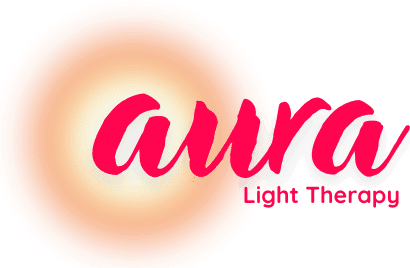
The Science of Red Light Therapy and Its Benefits for Skin Health

by Maritza Camerl, Licensed Esthetician at Aura Light Therapy
In the pursuit of healthy, radiant skin, many treatments promise results—but few are as backed by science as Red Light Therapy (RLT). Originally developed by NASA to promote wound healing in astronauts, this non-invasive technology has become a game-changer in skincare. By harnessing specific wavelengths of light, RLT works at the cellular level to boost collagen, reduce inflammation, and accelerate skin repair. Whether you're looking to smooth fine lines, calm acne, or restore a youthful glow, this cutting-edge therapy offers a gentle yet powerful way to improve skin health naturally.
How Red Light Therapy Works
Red Light Therapy, also known as low-level light therapy (LLLT) or photobiomodulation (PBM), utilizes specific wavelengths of red (600–700 nm) and near-infrared (700–1100 nm) light. Unlike ultraviolet (UV) light, which damages skin cells, red and near-infrared light interact with mitochondria—the energy-producing centers of cells—to stimulate adenosine triphosphate (ATP) production.
ATP fuels cellular repair and regeneration, allowing skin cells to function more efficiently. This process has been shown to increase collagen and elastin synthesis, improve circulation, reduce oxidative stress, and enhance the skin’s ability to heal itself.
Benefits of Red Light Therapy for Skin Health
Collagen is a critical protein responsible for maintaining skin firmness and elasticity. As we age, collagen production naturally declines, leading to the formation of fine lines and wrinkles. A study published in the Journal of Photochemistry and Photobiology found that Red Light Therapy stimulates fibroblast activity, resulting in increased collagen synthesis and significant improvements in skin texture and tone (Avci et al., 2013). Regular treatments can help reduce the appearance of fine lines and improve overall skin resilience.
Inflammation plays a major role in skin conditions such as acne, rosacea, and general skin irritation. Red Light Therapy has been shown to reduce pro-inflammatory cytokines, leading to a calming effect on the skin. Research published in Photomedicine and Laser Surgery demonstrated that Red Light Therapy significantly reduced inflammation and promoted faster healing in patients with acne vulgaris (Ablon, 2018). By decreasing redness and swelling, this therapy offers a gentle yet effective approach for those with sensitive or reactive skin.
Hyperpigmentation and sun damage are common concerns that develop due to excess melanin production. Red Light Therapy can help fade discoloration by accelerating cell turnover and reducing oxidative stress. This makes it a promising option for individuals seeking to achieve a more even skin tone.
Wound healing and scar reduction are also supported by Red Light Therapy. By promoting tissue repair, the treatment can help minimize post-inflammatory hyperpigmentation and improve the appearance of acne scars or surgical marks. Increased circulation delivers essential nutrients to the skin, further enhancing the body’s natural healing processes.
A healthy skin barrier is essential for hydration and protection against environmental damage. Red Light Therapy strengthens the outermost layer of the skin by reinforcing intercellular connections and improving moisture retention. This results in smoother, more hydrated skin with greater resilience to external stressors.
Integrating Red Light Therapy into Skincare Treatments
Red Light Therapy can be used as a standalone treatment or in combination with other skincare therapies to maximize results. Hydrating facials enhance moisture retention and plump the skin, while exfoliation improves light penetration and stimulates cell renewal. Antioxidant-rich serums complement Red Light Therapy by reducing oxidative stress and supporting overall skin health.
Professional estheticians can tailor treatments to individual skin concerns, ensuring optimal benefits from Red Light Therapy. Its non-invasive nature makes it suitable for most skin types and a viable alternative to more aggressive cosmetic procedures.
A Brighter Future for Your Skin
Red Light Therapy offers a unique, science-backed approach to improving skin health without invasive procedures or harsh chemicals. As research continues to uncover its full potential, it’s clear that light-based treatments are more than just a passing trend—they’re a promising tool for long-term skin wellness.
By supporting natural collagen production, reducing inflammation, and enhancing overall skin function, Red Light Therapy provides a gentle yet effective way to care for your skin at a cellular level. Whether incorporated into a professional skincare regimen or used as part of a broader wellness routine, its benefits are both practical and well-supported by science. As we learn more about the relationship between light and skin health, treatments like Red Light Therapy may continue to play a key role in how we approach skincare in the future.
References
Ablon, G. (2018). Phototherapy with blue (415 nm) and red (633 nm) light in the treatment of acne vulgaris. Photomedicine and Laser Surgery, 36(6), 317-323.
Avci, P., Gupta, A., Sadasivam, M., Vecchio, D., Pam, Z., Pam, N., & Hamblin, M. R. (2013). Low-level laser (light) therapy (LLLT) in skin: Stimulating, healing, restoring. Journal of Photochemistry and Photobiology B: Biology, 127, 126-129.
Questions?
Give us a call
(860) 751-9453
